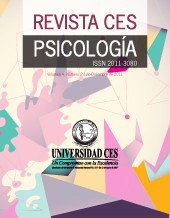Understanding the psychotherapeutic change in adolescents: Voices of patients and therapists
DOI:
https://doi.org/10.21615/cesp.13.3.7Keywords:
Qualitative Methods, Therapeutic Alliance, Adolescent Therapy, Change Processes, Psychotherapy with AdolescentsAbstract
This study aimed to understand the process of psychotherapeutic change from the subjective perspectives of adolescents and therapists who participated in therapy. Method: A qualitative approach was used; information was collected through a semi-structured audio-recorded interview, which occurred at the end of therapy. The participants were 17 therapeutic dyads (adolescents: average age 15.8 years; 64.7% female gender; therapists: average age 30.3 years; 55.5% female gender), who performed their therapies in natural contexts and with different theoretical approaches. Trained coders analyzed the data through the procedures proposed by the Grounded Theory, with open and axial coding, performing processes of permanent reorganizations and triangulations. Results: The results show two major phenomena related to the processes of change: (a) The encounter with "the other" as a safe platform and relational substrate to generate change and (b) Change as empowerment and development. Discussion: The central role of the therapeutic relationship and the achievement of developmental tasks (identity, autonomy and self-determination) in psychotherapeutic change is discussed. In addition, it also reflects on the skills and actions of the therapists.
Downloads
References
Almonte, C. (2019) Características generales de la psicopatología infantil y de la adolescencia. En C., Almonte, & M.E., Montt. (eds.). Psicopatología Infantil y de la Adolescencia. Tercera Edición (pp. 19 – 28).
Altimir, C., Capella, C., Núñez, L., Abarzua, M., & Krause, M. (2017). Meeting in difference: Revisiting the therapeutic relationship based on patients′ and therapists′ experiences in several clinical contexts. Journal of Clinical Psychology, 73(11), 1510-1522. https://doi.org/10.1002/jclp.22525
Benjet, C. (2009). La salud mental de la niñez y la adolescencia en América Latina y el Caribe. En J., Rodriguez, R., Kohn, & S., Aguliar-Gaxiola. (Eds) Epidemiología de los trastornos mentales en América Latina y el Caribe, (pp. 234-242) Washington, D.C.: Organización Panamericana de la Salud.
Bhola, P., & Kapur, M. (2013). The development and role of the therapeutic alliance in supportive psychotherapy with adolescents. Psychological Studies, 58(3), 207-215. https://doi.org/10.1007/s12646-013-0191-0
Binder, P. E., Holgersen, H., & Nielsen, G. H. (2008). Establishing a bond that works: A qualitative study of how psychotherapists make contact with adolescent patients. European Journal of psychotherapy and counselling, 10(1), 55-69. https://doi.org/10.1080/13642530701869730
Bordin, E. S. (1976). The generalizability of the psychoanalytic concept of the working Alliance. Psychotherapy: Theory, Research, and Practice, 16, 252 -260.
Capella, C., Soza, J., García, G., Sepúlveda, G., Quiroga, F., González, I., ... Vergara, P. (2017). Cambio psicoterapéutico en niños/as y adolescentes desde el enfoque constructivista evolutivo: evaluación de un caso. Revista Argentina de Clínica Psicológica, 26(1), 125-136.
Charmaz, K. (2006). Constructing grounded theory. A practical guide through qualitative analysis. Los Angeles, CA: Sage.
Corbin, J. M., & Strauss, A. (1990). Grounded theory research: Procedures, canons, and evaluative criteria. Qualitative sociology, 13(1), 3-21.
Corbella, S., & Botella, L. (2003). La alianza terapéutica: historia, investigación y evaluación. Anales de Psicología, 19(2), 205-221.
Creed, T. A., & Kendall, P. C. (2005). Therapist Alliance-Building Behavior within a Cognitive-Behavioral Treatment for Anxiety in Youth. Journal of Consulting and Clinical Psychology, 73(3), 498–505. https://doi.org/10.1037/0022-006X.73.3.498
Daly, A. M., Llewelyn, S., McDougall, E., & Chanen, A. M. (2010). Rupture resolution in cognitive analytic therapy for adolescents with borderline personality disorder. Psychology and Psychotherapy: Theory, Research and Practice, 83(3), 273-288. https://doi.org/10.1348/147608309X481036
Diamond, G., Siqueland, L., & Diamond, G.M. (2003). Attachment-Based Family Therapy for Depressed Adolescents: Programmatic Treatment Development. Clin Child Fam Psychol Rev, 6(2), 107–127. https://doi.org/10.1023/A:1023782510786
DiGiuseppe, R., Linscott, J., & Jilton R (1996) Developing the therapeutic alliance in child-adolescent psychotherapy. Applied and Preventive Psychology, 5(2), 85-100. https://doi.org/10.1016/S0962-1849(96)80002-3
Everall, R. D., & Paulson, B. L. (2002). The therapeutic alliance: adolescent perspectives. Counselling and Psychotherapy Research, 2(2), 78–87. https://doi.org/10.1080/14733140212331384857
Fernández, O. (2019). El trabajo con los padres en la terapia de niños y adolescentes. En C., Almonte, & M.E., Montt. (eds.). Psicopatología Infantil y de la Adolescencia. Tercera Edición (pp.762 – 769).
Fernández, O., Herrera-Salinas, P., & Escobar-Martínez, M. J. (2016). Adolescentes en psicoterapia: Su representación de la relación terapéutica. Revista Latinoamericana de Ciencias Sociales, Niñez y Juventud, 14(1), 559-575.
Fernández, O., Krause, M., & Pérez, J. C. (2016). Therapeutic alliance in the initial phase of psychotherapy with adolescents: different perspectives and their association with therapeutic outcomes. Research in Psychotherapy: Psychopathology, Process and Outcome, 19(1), 4–18. https://doi.org/10.4081/ripppo.2016.180
Fernández, O., Pérez, J. C., & Krause, M. (2019). The relation between the therapeutic alliance and communicative intentions in therapeutic interaction during the initial phase of adolescent therapy. Research in Psychotherapy: Psychopathology, Process and Outcome, 22(2), 189-198. https://doi.org/10.4081/ripppo.2019.356
Flick, U. (2012). Introducción a la investigación cualitativa. Madrid Ediciones Morata. Tercera reimpresión
Fonagy, P., Gergely, G., & Jurist, E. L. (Eds.). (2018). Affect regulation, mentalization and the development of the self. London: Routledge.
García, R. (2019). La salud mental y perspectivas clínicas en la infancia y la adolescencia. En C., Almonte, & M.E., Montt. (eds.). Psicopatología Infantil y de la Adolescencia. Tercera Edición (pp.243 – 249). Chile: Ed. Mediterráneo.
Gelso, C. J., & Kline, K. V. (2019). The sister concepts of the working alliance and the real relationship: on their development, rupture, and repair. Research in Psychotherapy: Psychopathology, Process and Outcome, 22(2), 142-149. https://doi.org/10.4081/ripppo.2019
Glaser, B. G., & Strauss, A. L. (2017). Discovery of grounded theory: Strategies for qualitative research. Third edition (First edition 1967). New York: Routledge.
Goodyer, I. M., Tsancheva, S., Byford, S., Dubicka, B., Hill, J., Kelvin, R., … Fonagy, P. (2011). Improving mood with psychoanalytic and cognitive therapies (IMPACT): a pragmatic effectiveness superiority trial to investigate whether specialised psychological treatment reduces the risk for relapse in adolescents with moderate to severe unipolar depression: study protocol for a randomised controlled trial. Trials, 12(1), 175 - 187. https://doi.org/10.1186/1745-6215-12-175
Hoffart, A., Borge, F- M., Sexton, H., Clark, D., & Wampold, B. (2012). Psychotherapy for social phobia: How do alliance and cognitive process interact to produce outcome? Psychotherapy Research, 22(1), 82 – 94. https://doi.org/10.1080/10503307.2011. 626806
Horvath, A. O. (2001). The therapeutic alliance: Concepts, research, and training. Australian Psychologist, 36(2), 170-176. https://doi.org/10.1080/00050060108 259650
Karver, M., Shirk, S., Handelsman, J. B., Fields, S., Crisp, H., Gudmundsen, G., & McMakin, D. (2008). Relationship processes in youth psychotherapy: Measuring alliance, alliance-building behaviors, and client involvement. Journal of Emotional and Behavioral Disorders, 16(1), 15-28. https://doi.org/10.1177%2F1063426607312536
Kazdin, A (2004). Psychotherapy for Children and Adolescents. En M., Lambert (Ed.), Bergin and Garfield’s Handbook of Psychotherapy and Behavior Change. New York: Wiley & Sons.
Kazdin, A. E. (2007). Mediators and mechanisms of change in psychotherapy research. Annual Review of Clinical Psychology, 3(1), 1-27. https://doi.org/10.1146/annurev.clinpsy.3.022806.091432
Kazdin, A. E. (2009). Understanding how and why psychotherapy leads to change. Psychotherapy research, 19(4-5), 418-428. https://doi.org/10.1080/10503300802448899
Kessler, R. C., Angermeyer, M., Anthony, J. C., De Graaf, R. O. N., Demyttenaere, K., Gasquet, I., ... Kawakami, N. (2007). Lifetime prevalence and age-of-onset distributions of mental disorders in the World Health Organization's World Mental Health Survey Initiative. World psychiatry, 6(3), 168.
Kessler, R. C., Berglund, P., Demler, O., Jin, R., Merikangas, K. R., & Walters, E. E. (2005). Lifetime prevalence and age-of-onset distributions of DSM-IV disorders in the National Comorbidity Survey Replication. Archives of General Psychiatry, 62(6), 593-602. https://doi.org/10.1001/archpsyc.62.6.593
Krause, M. (1995). La investigación cualitativa: Un campo de posibilidades y desafíos. Revista Temas de Educación, 7(7), 19-40.
Krause, M., Fernández, O. M., & Bräutigam, O. (2015). Ergebnisqualität von psychotherapeutischen Prozessen mit Jugendlichen. Psychotherapeut, 60(5), 419-425. https://doi.org/10.1007/s00278-015-0037-4
Kvale, S. (2011). Las entrevistas en investigación cualitativa. Madrid: Ediciones Morata.
Larsen, D., Flesaker, K., & Stege, R. (2008). Qualitative interviewing using Interpersonal Process Recall: Investigating internal experiences during professional-client conversation. International Journal of Qualitative Method, 7(1), 18-37. https://doi.org/10.1177/160940690800700102
Levisky, D. L. (1999). Adolescencia: reflexiones psicoanalíticas. Buenos Aires: Editorial Lumen.
Manríquez, H., Molina, H., & Zubarew, T. (2003). Promoción y prevención de salud en la adolescencia. Adolescencia, promoción, prevención y atención de salud. Santiago: Ediciones Universidad Católica de Chile.
Marchesi, Á., Palacios, J., & Coll, C. (2017). Desarrollo psicológico y educación. Madrid: Alianza Editorial.
Martin, D.J., Garske, J.P., & Davies, M.K. (2000). Relation of therapeutic alliance with outcome and other variables: A meta-analytic review. Journal of Consulting and Clinical Psychology, 68(3), 438-450. https://doi.org/10.1037/0022-006X.68.3.438
Midgley, N., Capella, C., Goodman, G., Lis, A., Noom, M., Tishby, O., & Weitkamp, K. (2018). Introduction to the special section on child and adolescent psychotherapy research. Psychotherapy Research, 28(1), 1-2. https://doi.org/10.1080/10503307.2017.1380864
Morán, J., Díaz, M. F., Martínez, C., Varas, C., & Sepúlveda, R. P. (2019). The subjective experience of psychotherapists during moments of rupture in psychotherapy with adolescents. Research in Psychotherapy: Psychopathology, Process and Outcome, 22(1), 34-44. https://doi.org/10.4081/ripppo.2019.346
Páramo, M. (2011). Psicología Clínica de Niños y Adolescentes Psicoterapia para Adolescentes y Perfil del Psicólogo: Análisis de contenido de discursos grupales. Revista Argentina de Clínica Psicológica, 20(2), 133-142. Recuperado de https://www.redalyc.org/articulo.oa?id=2819/281922823004
Ponterotto, J. G. (2006). Brief note on the origins, evolution, and meaning of the qualitative research concept “thick description”. The Qualitative Report, 11(3), 538-549.
Russell, R. (2008). Child and Adolescent psychotherapy: Introduction to the special section. Psychotherapy Research, 18(1), 1-4. https://doi.org/10.1080/1050330070 1725090
Russell, R., Shirk, S., & Jungbluth, N. (2008). First-session pathways to the working alliance in cognitive–behavioral therapy for adolescent depression. Psychotherapy Research, 18(1), 15-27. https://doi.org/10.1080/10503300701697513
Safran, J. D., & Muran, J. C. (2006). Has the concept of the alliance outlived its usefulness? Psychotherapy, 43, 286–291. https://doi.org/10.1037/0033-3204.43.3.286
Schenk, N., Zimmermann, R., Fürer, L., Krause, M., Weise, S., Kaess, M., ... Schmeck, K. (2019). Trajectories of alliance ruptures in the psychotherapy of adolescents with borderline personality pathology: timing, typology and significance. Research in Psychotherapy: Psychopathology, Process and Outcome, 22(2), 199-211. https://doi.org/10.4081/ripppo.2019.348
Shirk, S., & Karver, M. (2003). Prediction of treatment outcome from relationship variables in child and adolescent therapy: A metanalytic review. Journal of Consulting and Clinical Psychology, 71(3),452-464. https://doi.org/10.1037/0022-006X.71.3.452
Stern, D. (1985). The interpersonal world of the infant: A view from psychoanalysis and developmental psychology. New York: Basic Books.
Weisz, J. R., Sandler, I. N., Durlak, J. A., & Anton, B. S. (2005). Promoting and protecting youth mental health through evidence-based prevention and treatment. American Psychologist, 60(6), 628-648. https://doi.org/10.1037/0003-066X.60.6.628
Weisz, J. R., & Kazdin, A. E. (Eds.). (2010). Evidence-based psychotherapies for children and adolescents. New York: Guilford Press.
Downloads
Published
How to Cite
Issue
Section
License
Copyright (c) 2020 CES Psicología

This work is licensed under a Creative Commons Attribution-NoDerivatives 4.0 International License.
Each manuscript is accompanied by a statement specifyingThat the materials are unpublished, that have not been previously published in printed formatElectronic and that they will not be presented to any other means before knowing the decision of the magazine. ThroughoutIn case, any previous publication, sea in printed or electronic form, must be made known to the editorial staffWriting The authors attach a signed statement stating that, and the manuscript is acceptedFor publication, the rights of reproduction are the exclusive property of the Journal CES Psychology.


